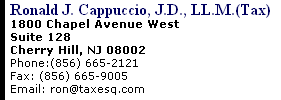
Pension
Protection Act of 2006 - Part 2
|
More
Highlights of the
Pension Protection
Act |
On
August 17, 2006, President Bush signed the massive Pension
Protection Act of 2006 into law. Although the legislation
contains numerous changes affecting retirement plans and
accounts, it also contains a host of tax provisions that
affect charitable donors and organizations. Some of the new
rules are beneficial to taxpayers. However, others are not.
Here are the most important charitable contribution changes:
|
All Cash Donations
Must Be
Documented |
 | Under
the new law, a charitable donor will not be allowed a
write-off for contributions of cash, checks, or other monetary
gifts unless the donor
|
More Generous Rules for
Qualified Conservation Contributions
For 2006 and 2007,
the Pension Protection Act includes temporary
liberalized deduction rules for "qualified conservation
contributions" by individuals to traditional public
charities (Section 170(b)(1)(A) organizations).
This basically means standard public charities. Here's a
rundown of the new rules:
The maximum
write-off for such contributions is increased from 30 to
50 percent of adjusted gross income.
- Qualified
conservation contributions are not counted when
calculating an individual’s allowable write-offs for
other charitable contributions.
- Qualified
conservation contributions in excess of what can be
written off in the year of the donation can be carried
forward for up to 15 years (only a five-year carryover
period is allowed under the normal rules).
- For a qualified
farmer or rancher, the conservation contribution
write-off for donated farm or ranch real property can
be as much as 100 percent of the donor’s adjusted
gross income. However, the donation must include a
usage restriction stating that the property is
required to remain available for agricultural or
livestock production. (This restriction is not
required for 2006 contributions that occurred before
August 17, 2006.)
- For qualified
conservation contributions by a non-publicly traded
corporation that is a qualified farmer or rancher, the
allowable deduction can shelter as much as 100 percent
of taxable income.
- Qualified corporate
contributions in excess of what can be written off in
the donation year can be carried forward up to 15
years.
Numerous Other Strict New
Rules
Here are some unfavorable new
rules in the new law (this is not a complete list):
- Harsh restrictions
on write-offs for donations of certain easements
located in registered historic districts.
- Stricter rules for
donations of fractional interests in tangible personal
property.
- For annual periods
beginning after 2006, small tax-exempt organizations
that are not required to file annual Forms 990 with
the IRS (generally organizations with annual gross
receipts of less than $25,000) must file annual
statements that provide basic contact information and
financial data.
- Some charities must
make copies of their annual Forms 990T filed with the
IRS (unrelated business taxable income returns)
available for public inspection. This rule applies to
affected returns filed after the August 17, 2006,
enactment date.
- For the period
ending two years after the August 17, 2006,
enactment date,
temporary new reporting requirements apply to
acquisitions by charities of interests in certain life
insurance contracts.
- Credit counseling
agencies will face stricter rules when attempting to
qualify for tax-exempt status.
- Harsher rules for
donations of
taxidermy.
| retains
either a bank record that supports the donation (for example,
a cancelled check) or a written communication from the
recipient charity that meets specified requirements. This
unfavorable new rule will kick in starting with tax years that
begin after the new law’s date of enactment. This means
calendar 2007 for most individual donors although it could be
sooner for some donors with non-calendar tax years.
The existing rule that requires donors to obtain
charity-provided substantiation for cash contributions of $250
or more remains in force. Cash donations under the $250
threshold will fall under the new rule imposed by the
Pension Protection Act.
Key Point: Once the new rule takes effect,
undocumented cash contributions, such as money placed on
church collection plates and cash dropped into Salvation Army
pots, won’t result in any write-offs for donors.
|
Stricter
Rules For
Donated Clothing
And Other
Items |
|

| Effective
for donations after August 17, 2006, no deductions will be
allowed for contributions of clothing and household items that
are not in "good used condition or better."
Congress
also gave the IRS authority to issue rules stating that
deductions would be denied for items of "minimal monetary
value, such as used socks..."
For purposes of this new
rule, “household items” includes furniture, electronics,
appliances and linens. A favorable exception allows write-offs
for single items that are not in "good" condition or better if
they are appraised at more than $500.
|
Donations Can
Be Made
Directly Out of IRAs
|
|

| The
new law permits an individual who is age 70 1/2 or older to
arrange for distributions of otherwise taxable traditional and
Roth IRA amounts paid directly to certain tax-exempt
charities. Such distributions are free from federal income tax
for the donor, but no deduction is allowed. However, the
tax-free treatment equates to a 100 percent write-off. This
favorable new rule for “qualified charitable distributions” is
available for 2006 and 2007, but no more than $100,000 can be
donated under the new rule in either of those years.
Under the pre-Pension Protection Act rules, a
person who wanted to donate money from an IRA had to take a
withdrawal from the account, include the taxable amount of the
withdrawal in income, donate the cash to charity, and hope for
the best in claiming an itemized charitable donation
write-off. Unfortunately, tax-law limitations on itemized
charitable deductions sometimes caused the allowable deduction
to be less than the income triggered by the IRA withdrawal.
The new law eliminates that problem, but only for 2006 and
2007. And unless Congress takes further action, the previous
rules will come back into play after 2007.
“Qualified charitable distributions” mean payments by an
IRA trustee directly to a qualified public charity (certain
donor-advised funds are excluded). A special calculation must
be made to figure the amount of a qualified charitable
distribution when the donor owns one or more IRAs to which
nondeductible contributions have been made. The new rule
cannot be used for SEP accounts or SIMPLE IRAs.
Remember: Qualified charitable contributions are free
from federal income tax, but they don’t generate a write-off
for the donor.
Key Point: The new rule is beneficial for older
taxpayers who don’t itemize and for those who would be
adversely affected by the limitations on itemized charitable
donation write-offs.
|
Extension
of Tax Break
For Food
Inventory
Donations |
|

| As
you may recall, the Katrina Emergency Tax Relief Act of
2005 temporarily allowed enhanced charitable deductions
for non-C corporation businesses that donated food
inventories. This write-off was for donations made between
August 28, 2005 and December 31, 2005. The Pension
Protection Act extends this break through December 31,
2007.
Under the normal tax rules, a food inventory
donation by a non-C-corporation business is limited to the
lesser of the inventory’s tax basis or fair market value. The
enhanced deduction is bigger. It equals the lesser of the
inventory’s tax basis, plus 50 percent of the appreciation in
value, or 200 percent of the tax basis.
To be eligible
for the enhanced deduction, the food generally must be donated
to a Section 501(c)(3) tax-exempt organization. In addition,
the organization must use the food consistent with its exempt
purpose solely for the care of the ill, the needy, or infants.
The organization must not transfer the food for money, other
assets, or services. Finally, the organization must give the
donor a written statement that these requirements will be met.
Key Point: For non-C corporation businesses, the
total write-off for donations of food inventories under the
enhanced deduction rule generally cannot exceed 10 percent of
the net income for the year from all sole proprietorships, S
corporations, or partnerships (or other non‑C corporation
entities) from which the donations are made.
|
Tax
Break Extension
For Books Donated
By C
Corporations |
|

| The
Katrina Emergency Tax Relief Act of 2005 also
temporarily allowed enhanced charitable deductions for
qualified book contributions by C corporations between August
28, 2005 and December 31, 2005. The Pension Protection
Act extends this break through December 31, 2007. The
enhanced deduction equals the lesser of:
- The tax basis of the books, plus 50 percent of the
appreciation in value or
- 200 percent of the tax basis.
Qualified book donations must go to schools that provide
elementary or secondary education, normally maintain a regular
faculty and curriculum, and have a regularly enrolled student
body. The enhanced deduction is only allowed if the recipient
school provides the donor with a written statement certifying
that the contributed books are suitable for use in the
school’s educational programs and will be used for that
purpose.
|
New Tax
Break
For S Corporation
Donations |
|

|
For 2006 and 2007, the Pension Protection Act
provides a temporary new tax incentive to encourage S
corporations to make charitable donations of appreciated
assets. For such contributions, each shareholder’s tax basis
in his or her S corporation stock is only reduced by the
shareholder’s pro-rata percentage of the company’s tax basis
in the donated assets.
Under the pre-Pension
Protection Act rules, a shareholder’s basis reduction was
equal to the passed-through deduction for the donation. When
appreciated assets (fair market value in excess of tax
basis) were given, the resulting write-off and shareholder
stock basis reduction often exceeded the shareholder’s
pro-rata percentage of the company’s basis in the donated
assets. The temporary new rule is beneficial to taxpayers
because it leaves shareholders with a higher basis in their S
corporation stock (higher stock basis is almost always
beneficial to shareholders).
(For information about
other provisions in the Pension Protection Act, click
here to read our previous
article.)
| |











